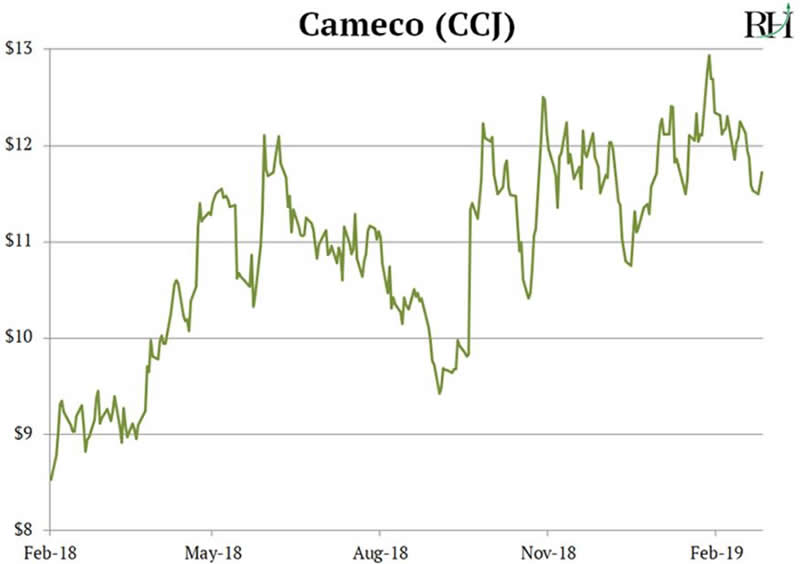Why the Green New Deal Will Send Uranium Price Through the Roof / Commodities / Uranium
 Haveyou heard of Alexandria Ocasio-Cortez?
Haveyou heard of Alexandria Ocasio-Cortez?
At29 years old, she’s the youngest Congressperson in history.
Alsoknown as “AOC,” Cortez is quite a sensation among young left-leaning folks. Nosurprise, she’s often referred to as the Democratic version of Trump. 2.4million fans follow her on Twitter.
Likeany socialist, AOC is full of “ideas.” Most of them involve taking money fromone group of people and giving it to another.
She’scalling for a 70% top tax rate, for example. And free college. And giving freemoney to those “unwilling to work.”
ButI want to set politics aside to tell you about her silliest idea of all. Shedoesn’t know it, but this idea will send one beaten down stock through theroof…
Onethat soared 3,000% the last time it was in a bull market.
AOC’s Big Idea Is Called the Green NewDeal
TheGreen New Deal aims to have America running on 100% clean energy by 2030.
AOChas called climate change her “World War II.” She wants to get rid of dirtyenergy like coal, oil, and gas that pollute the air.
Soundspretty good, right? A clean environment is important for all of us. I certainlywant my young daughter to grow up breathing clean air.
Butthere’s one big problemwith AOC’s plan.
The Green New Deal Excludes the CleanestEnergy Source of All
Accordingto AOC "there is no place fornuclear power” in America’s future.
Manyfolks think nuclear power is dirty and dangerous. They associate it with bigsmokestacks and nuclear bombs.
Thesepeople could not be more wrong. Nuclear is the best source of renewable, cleanenergy we have.
Itdoesn’t cause any pollution. The steam drifting out of nuclear plants is asharmless as the steam from your shower.
Infact, the International Panel on Climate Change found nuclearpower produces less airpollution than solar, wind, or hydro.
Itis also the safest energy source on the planet, according to the World HealthOrganization.
The Green New Deal Can’t Succeed WithoutNuclear
Thereare 99 nuclear reactors in the US. They generate twice as much clean energy asevery solar panel, wind turbine, and other clean energy source combined.
Excludingnuclear, clean energy sources like solar and wind make up 17% of America’senergy needs. Getting that to 100% by 2030 without nuclear is impossible.
Forone, it would cost trillions of dollars.
Also,we need energy sources that are dependable and “always on.” This is a majorproblem for solar and wind.
Solarpower is interrupted by darkness and clouds. Wind turbines only work when thewind blows. That’s why solar generates power only 25% of the time and wind 35%of the time.
This Is How the Uranium Sector Collapsed
Asyou likely know, nuclear power plants use uranium as fuel to produceelectricity.
But the uranium sector has collapsed since 2011.
Itbegan with the freak accident in Fukushima, Japan. First, the most powerfulearthquake in Japan’s history caused a reactor to shut down. Then a tsunamidisabled the emergency generators.
Thiscaused a disastrous nuclear meltdown that contaminated a large area and killedand injured many people.
Japanshut down all but two of its reactors after the Fukushima disaster. Many othercountries followed suit.
Germanymoved to phase out nuclear power completely. And plans to build four newreactors in America were shelved.
Uranium Demand Plunged and Its PriceCratered 86%
Thisled to the vast majority of uranium companies shutting their doors.
In2011, there were 585 uranium companies. Just 40 remain operational today. Andmost of the survivors have seen their stocks plunge 90% or worse.
Lastyear, uranium production in the US dropped to its lowest level since the 1950s.That’s because almost no producer can make money at today’s depressed prices.
Uranium Has Nowhere to Go but Up
It’sa total bloodbath. But as I explained last year, the uranium market is poisedto surge higher. You can review my whole case for uranium here.
Inshort, nuclear use around the world is growing. 57 new reactors are nowbeing built. And uranium demand is expected to rise 23% by 2025.
Yeturanium stocks are priced as if nuclear energy is being phased out altogether.
Despitewhat the Green New Deal says, it’s not. I guarantee nuclear power will be a bigpart of America and the world’s clean energy future.
Cameco (CCJ) Is Hands Down My FavoriteUranium Stock
Camecois the world’s biggest uranium producer. In fact, it’s one of my top picks for 2019, period.
I recommended Cameco to you in August. It has climbed 10% since then.And it’s up 30% in the past year:
Camecoproduces around 15% of the world’s uranium. It operates two of the highest-qualityuranium mines in the world. Both are located in Canada’s Athabasca Basin. Andthe quality of the uranium there is 100x better than the global average.
Thisallows Cameco to produce uranium for less than its competitors. Most companiesmine it for $50–$60/lb. Cameco does it for around $35/lb.
Akey thing to know about uranium stocks is they move in massive cycles. The “up”part of the cycle can produce some of the biggest gains you’ll ever see.
Forexample, when the uranium price ran from $10/lb to $136/lb between 2000 and2007, Cameco shot up over 3,000%.
Overthe next few years, as reality dawns on the markets, we have a great shot totriple our money or better in Cameco.
Andgiven that it rocketed 30x in the last uranium bull market, it could easily goa lot higher.
By Stephen McBride
© 2019 Copyright Stephen McBride- All Rights Reserved Disclaimer: The above is a matter of opinion provided for general information purposes only and is not intended as investment advice. Information and analysis above are derived from sources and utilising methods believed to be reliable, but we cannot accept responsibility for any losses you may incur as a result of this analysis. Individuals should consult with their personal financial advisors.
© 2005-2019 http://www.MarketOracle.co.uk - The Market Oracle is a FREE Daily Financial Markets Analysis & Forecasting online publication.
